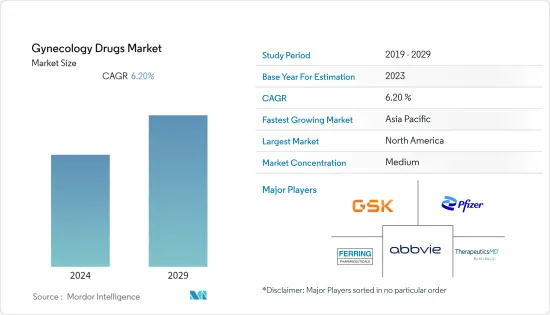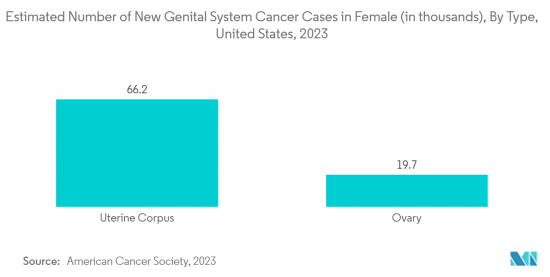 |
市場調査レポート
商品コード
1405701
婦人科治療薬:市場シェア分析、産業動向・統計、成長予測、2024~2029年Gynecology Drugs - Market Share Analysis, Industry Trends & Statistics, Growth Forecasts 2024 - 2029 |
||||||
● お客様のご希望に応じて、既存データの加工や未掲載情報(例:国別セグメント)の追加などの対応が可能です。 詳細はお問い合わせください。
| 婦人科治療薬:市場シェア分析、産業動向・統計、成長予測、2024~2029年 |
|
出版日: 2024年01月04日
発行: Mordor Intelligence
ページ情報: 英文 115 Pages
納期: 2~3営業日
|
- 全表示
- 概要
- 目次
婦人科治療薬市場は予測期間中にCAGR 6.2%で成長すると予測されます。

主なハイライト
- COVID-19パンデミックは、最初のパンデミック時に婦人科疾患患者の管理にかなりの影響を与えました。例えば、2022年8月にSAGE Journalsが発表した研究によると、パンデミック期間中、婦人科系がんの管理は、ロックダウンの影響もあり、またCOVID-19患者の管理にリソースを振り向けたこともあり、苦戦を強いられました。また、パンデミック時の婦人科系がん管理の修正が推奨されるとも述べられています。このような事例から、パンデミック期間中、市場は伸び悩んだと考えられます。しかし、規制や閉鎖が緩和され、COVID-19の症例が減少していることから、市場は予測期間中に大幅に成長すると予想されます。
- 調査対象市場の成長を促進する主な要因としては、婦人科疾患の負担増、女性の高齢化とともにヘルスケア意識の高まりなどが挙げられます。
- 様々な婦人科疾患の罹患率の上昇は今後も続くと予測されており、効率的な治療に対する需要を煽り、予測期間にわたって世界の婦人科治療薬市場を牽引すると思われます。Cureusが2022年8月に発表した記事によると、インドで調査が行われ、調査参加者の多嚢胞性卵巣症候群(PCOS)の有病率は6.8%でした。この情報源はまた、多嚢胞性卵巣症候群は思春期や若い女性の間で非常に一般的な健康問題であるとも述べています。したがって、このような疾患の負担が大きいことが、市場の成長を押し上げると予想されます。
- さらに、2022年1月に米国国立がん研究所が発表したデータによると、2022年の米国における新規子宮頸がん患者数の推計値は約14,100人で、新規がん患者数全体の約0.7%増となっています。同様に、米国がん協会が2022年1月に発表した報告書によると、2022年に新たに卵巣がんの診断を受ける女性は約19,880人と予想されています。したがって、このような婦人科系がんの高い有病率は、婦人科治療薬の需要を促進し、それによって市場の成長を促進すると予想されます。
- さらに、主要な市場参入企業による新たな展開も、市場の成長を後押ししています。 例えば、2021年5月、Myovant Sciences社とPfizer Inc.は、閉経前女性の子宮筋腫に伴う月経多量出血の管理に対する初の1日1回治療薬であるMYFEMBREEの承認を米国食品医薬品局(USFDA)から取得した(治療期間は最長24カ月)。
- しかし、高コストと製品の承認を遅らせる厳しい規制の枠組みが、予測期間中の市場成長を阻害する可能性が高いです。
婦人科治療薬市場の動向
非ホルモン療法分野は予測期間中に高成長が見込まれる
- 非ホルモン療法セグメントは予測期間中に高成長が見込まれます。同分野の有利な成長は、治療効率が実証されていること、副作用の少ない新製品開発が急速に進んでいること、幅広い市場製品が入手可能であることなどから、これらの製品の採用が増加していることに起因しています。さらに、ホルモン療法に伴う乳がんリスクやその他の合併症などの欠点が、予測期間中に非ホルモン療法製品の需要を促進すると予想されています。
- 非ホルモン療法の有効性と利点を測定するために、様々な研究が行われています。例えば、2022年3月にPubMedによって発表された研究によると、NLRP3/IL-1ホイールは子宮内膜症の病因に関与しており、NLRP3阻害剤は卵巣子宮内膜症の抑制や子宮内膜症を有する卵巣の機能改善に有用である可能性があります。
- また、様々な症状に対する新たな非ホルモン療法薬の上市に向けた臨床試験の増加も、同分野の成長を加速させています。例えば、2021年10月、Bayer社は、更年期の血管運動症状の治療に対するエリンザネッタントの有効性と安全性を評価することを目的とした第III相臨床開発プログラムOASISを開始しました。
- したがって、非ホルモン療法に関する研究や臨床試験の増加により、婦人科系がんの治療における非ホルモン療法の適用に対する認識が高まると予想されます。従って、予測期間中に大幅な成長が見込まれます。

北米が婦人科治療薬市場で大きなシェアを占める見込み
- 予測期間中、北米は婦人科治療薬市場で大きなシェアを占めるとみられます。この優位性は、同地域の女性の多忙なライフスタイルやストレスの増加により、乳がん、更年期障害、多嚢胞性卵巣症候群などの罹患率が上昇していることが主な理由です。
- 例えば、カナダがん協会が2022年5月に発表した報告書によると、2022年には約1,450人のカナダ人女性が子宮頸がんと診断されると推定されています。さらに、高度なヘルスケアインフラが整備されていること、女性のヘルスケア意識向上のための政府支出が増加していること、高齢女性人口が増加していることに加え、同地域では品質が強化された製品が早期に発売されていることも、予測期間中の市場成長に寄与すると予想されます。
- 主要製品の上市、市場プレイヤーやメーカーのプレゼンスの集中、主要プレイヤー間の買収や提携、米国における婦人科系がんの有病率の高さなどは、同地域の婦人科治療薬市場の成長を促進する要因の一部です。
- 例えば、米国がん協会が2022年1月に発表した報告書によると、乳がんは米国で女性に最も多いがんであり、毎年新たに発生する女性のがんの約30.0%、3人に1人が乳がんです。このような高い有病率は、婦人科治療薬の需要を急増させると予想され、予測期間中の米国における市場成長を促進します。
婦人科治療薬産業の概要
婦人科治療薬市場は適度な競争があり、複数の大手企業が参入しています。同市場の一部の有力プレーヤーは、新製品の上市や買収など様々な戦略を実施し、世界中で市場での地位を固めています。競合情勢には、Allergan Plc、Pfizer Inc、AbbVie Inc、TherapeuticsMD Inc、Ferring Holding SAなど、市場シェアを持ち知名度の高い国際企業や地元企業の分析が含まれます。
その他の特典:
- エクセル形式の市場予測(ME)シート
- 3ヶ月間のアナリストサポート
目次
第1章 イントロダクション
- 調査の前提条件と市場定義
- 調査範囲
第2章 調査手法
第3章 エグゼクティブサマリー
第4章 市場力学
- 市場概要
- 市場促進要因
- 婦人科疾患の負担増
- 女性の高齢化に伴うヘルスケア意識の高まり
- 市場抑制要因
- 薬剤の承認を遅らせる高コストと厳しい規制枠組み
- ポーターのファイブフォース分析
- 新規参入業者の脅威
- 買い手/消費者の交渉力
- 供給企業の交渉力
- 代替品の脅威
- 競争企業間の敵対関係の強さ
第5章 市場セグメンテーション(市場規模、金額ベース)
- 治療薬別
- ホルモン療法
- 非ホルモン療法
- 適応症別
- 婦人科系がん
- 更年期障害
- 多嚢胞性卵巣症候群
- 避妊
- その他の適応症
- 流通チャネル別
- 病院薬局
- 小売薬局
- オンライン薬局
- 地域別
- 北米
- 米国
- カナダ
- メキシコ
- 欧州
- ドイツ
- 英国
- フランス
- イタリア
- スペイン
- その他欧州
- アジア太平洋
- 中国
- 日本
- インド
- オーストラリア
- 韓国
- その他アジア太平洋地域
- 中東・アフリカ
- GCC
- 南アフリカ
- その他中東とアフリカ
- 南米
- ブラジル
- アルゼンチン
- その他南米
- 北米
第6章 競合情勢
- 企業プロファイル
- Pfizer Inc.
- AbbVie Inc.
- TherapeuticsMD Inc.
- Ferring Holding SA
- Lupin Pharmaceuticals Inc
- Johnson & Johnson
- Eli Lilly and Company
- Bayer AG
- GSK plc
- Abbott Laboratories Ltd.
- AstraZeneca
第7章 市場機会と今後の動向

The gynecology drugs market is expected to register a CAGR of 6.2% over the forecast period.
Key Highlights
- The COVID-19 pandemic considerably impacted the management of patients with gynecologic diseases during the initial pandemic. For instance, according to a study published by SAGE Journals in August 2022, the management of gynecological cancers suffered during the pandemic, partly due to lockdowns and partly due to directing resources to manage COVID-19 patients. It was also stated that modification of gynecological cancer management during the pandemic was recommended. Therefore, such instances indicated that the market witnessed slow growth during the pandemic. However, with the easing of restrictions and lockdowns and declining cases of COVID-19, the market was expected to witness considerable growth over the forecast period.
- The major factors driving the growth of the studied market include the increasing burden of gynecological diseases and the rise in healthcare awareness along with the increasing aging female population.
- The rising incidence of various gynecological diseases is projected to continue in the future, which is likely to fuel the demand for efficient treatment, driving the global gynecological drugs market over the forecast period. According to an article published by Cureus in August 2022, a study was conducted in India, which showed that the prevalence of polycystic ovary syndrome (PCOS) was 6.8% among the study participants. The source also stated that polycystic ovary syndrome is a very common health problem among adolescents and young girls. Thus, the high burden of such diseases is expected to boost the market growth.
- Moreover, according to the data published by the National Cancer Institute in January 2022, the estimated number of new cervical cancer cases in 2022 was around 14,100 in the United States, which is around 0.7% up from previous years of all new cancer cases. Similarly, as per the report published by the American Cancer Society in January 2022, around 19,880 women were expected to receive a new diagnosis of ovarian cancer in 2022. Therefore, such a high prevalence of gynecology cancers is expected to fuel the demand for gynecology drugs, thereby propelling the market growth.
- Moreover, the rising developments by key market players are also enhancing the market growth. For instance, in May 2021, Myovant Sciences and Pfizer Inc. received approval from the United States Food and Drug Administration (USFDA) for MYFEMBREE, the first once-daily treatment for the management of heavy menstrual bleeding associated with uterine fibroids in premenopausal women, with a treatment duration of up to 24 months.
- However, the high cost and stringent regulatory framework that delays the approval of products are likely to impede market growth over the forecast period.
Gynecology Drugs Market Trends
Non-hormonal Therapy Segment is Expected to Witness High Growth Over the Forecast Period
- The non-hormonal therapy segment is expected to have a high growth rate over the forecast period. The lucrative growth of the segment can be attributed to the rise in the adoption of these products due to proven efficiency in the treatment, rapid advancements in new product development with reduced side effects, and the availability of a wide range of marketed products. Furthermore, the disadvantages of hormonal therapy, such as the risk of breast cancer and other complications associated with these products, are expected to foster the demand for non-hormonal products during the forecast period.
- Various studies are being conducted to measure the effectiveness and advantages of non-hormonal therapy. For instance, according to the study published by PubMed in March 2022, NLRP3/IL-1β is involved in the pathogenesis of endometriosis, and the NLRP3 inhibitor may be useful for suppressing ovarian endometriosis and improving the function of ovaries with endometriosis.
- In addition, increasing clinical trials for launching new non-hormonal therapy drugs for various symptoms are also surging the segment growth. For instance, in October 2021, Bayer commenced the Phase III clinical development program OASIS, which aims to evaluate the efficacy and safety of elinzanetant for the treatment of vasomotor symptoms during menopause.
- Therefore, increasing studies on non-hormonal therapy and clinical trials are expected to increase awareness of the application of non-hormonal therapy in treating gynecological cancers. Hence, significant segment growth is anticipated over the forecast period.

North America is Expected to Hold a Significant Share in the Gynecology Drugs Market
- North America is expected to hold a significant share of the gynecology drugs market over the forecast period. This dominance is mainly owing to rising incidences of breast cancer, menopausal disorders, polycystic ovary syndrome, and others due to busy lifestyles and the rise in stress among the women in the region.
- For instance, as per the report published by the Canadian Cancer Society in May 2022, it is estimated that around 1,450 Canadian women will be diagnosed with cervical cancer in 2022. Moreover, the availability of advanced healthcare infrastructure, an increase in government expenditure for women's healthcare awareness, and the senior women population, along with early product launches with enhanced quality in the region, are expected to contribute to the market growth over the forecast period.
- Key product launches, high concentration of market players or manufacturers' presence, acquisition and & partnerships among major players, and the high prevalence of gynecological cancers in the United States are some of the factors driving the growth of the gynecology drugs market in the region.
- For instance, as per the report published by the American Cancer Society in January 2022, breast cancer is the most common cancer in women in the United States, which is about 30.0% or 1 out of 3 of all new female cancers each year. Such high prevalence is anticipated to surge the demand for gynecology drugs, thereby propelling the market growth in the United States over the forecast period.
Gynecology Drugs Industry Overview
The gynecology drugs market is moderately competitive and consists of several major players. Some prominent players in the market are implementing various strategies, such as launching new products and making acquisitions to consolidate their market positions across the globe. The competitive landscape includes an analysis of a few international as well as local companies that hold the market shares and are well known, including Allergan Plc, Pfizer Inc, AbbVie Inc, TherapeuticsMD Inc, and Ferring Holding SA, among others.
Additional Benefits:
- The market estimate (ME) sheet in Excel format
- 3 months of analyst support
TABLE OF CONTENTS
1 INTRODUCTION
- 1.1 Study Assumptions and Market Definition
- 1.2 Scope of the Study
2 RESEARCH METHODOLOGY
3 EXECUTIVE SUMMARY
4 MARKET DYNAMICS
- 4.1 Market Overview
- 4.2 Market Drivers
- 4.2.1 Increasing Burden of Gynecological Diseases
- 4.2.2 Rise in Healthcare Awareness Along with Increasing Ageing Female Population
- 4.3 Market Restraints
- 4.3.1 High Cost and Stringent Regulatory Framework that Delays the Approval of the Drugs
- 4.4 Porter's Five Forces Analysis
- 4.4.1 Threat of New Entrants
- 4.4.2 Bargaining Power of Buyers/Consumers
- 4.4.3 Bargaining Power of Suppliers
- 4.4.4 Threat of Substitute Products
- 4.4.5 Intensity of Competitive Rivalry
5 MARKET SEGMENTATION (Market Size by Value - USD)
- 5.1 By Therapeutics
- 5.1.1 Hormonal Therapy
- 5.1.2 Non-hormonal Therapy
- 5.2 By Indication
- 5.2.1 Gynecology Cancers
- 5.2.2 Menopausal Disorder
- 5.2.3 Polycystic Ovary Syndrome
- 5.2.4 Contraception
- 5.2.5 Other Indications
- 5.3 By Distribution Channel
- 5.3.1 Hospital Pharmacies
- 5.3.2 Retail Pharmacies
- 5.3.3 Online Pharmacies
- 5.4 Geography
- 5.4.1 North America
- 5.4.1.1 United States
- 5.4.1.2 Canada
- 5.4.1.3 Mexico
- 5.4.2 Europe
- 5.4.2.1 Germany
- 5.4.2.2 United Kingdom
- 5.4.2.3 France
- 5.4.2.4 Italy
- 5.4.2.5 Spain
- 5.4.2.6 Rest of Europe
- 5.4.3 Asia-Pacific
- 5.4.3.1 China
- 5.4.3.2 Japan
- 5.4.3.3 India
- 5.4.3.4 Australia
- 5.4.3.5 South Korea
- 5.4.3.6 Rest of Asia-Pacific
- 5.4.4 Middle East and Africa
- 5.4.4.1 GCC
- 5.4.4.2 South Africa
- 5.4.4.3 Rest of Middle East and Africa
- 5.4.5 South America
- 5.4.5.1 Brazil
- 5.4.5.2 Argentina
- 5.4.5.3 Rest of South America
- 5.4.1 North America
6 COMPETITIVE LANDSCAPE
- 6.1 Company Profiles
- 6.1.1 Pfizer Inc.
- 6.1.2 AbbVie Inc.
- 6.1.3 TherapeuticsMD Inc.
- 6.1.4 Ferring Holding SA
- 6.1.5 Lupin Pharmaceuticals Inc
- 6.1.6 Johnson & Johnson
- 6.1.7 Eli Lilly and Company
- 6.1.8 Bayer AG
- 6.1.9 GSK plc
- 6.1.10 Abbott Laboratories Ltd.
- 6.1.11 AstraZeneca
